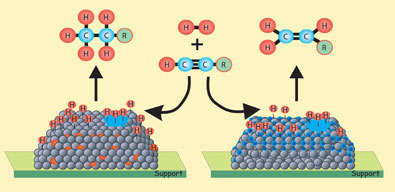博文
More to catalysis than meets the eye
|
More to catalysis than meets the eye
04 April 2008
Catalysts are more than just a reactive surface, say chemists in Europe - changes beneath the metal's skin can completely change the course of a reaction. Studying the palladium-catalysed hydrogenation of alkynes, Detre Teschner at the Fritz-Haber-Institute, Berlin, and colleagues have revealed that the reaction's outcome depends entirely on the presence - or absence - of subsurface hydrogen.
Catalytic hydrogenation is used in industry to selectively convert alkynes into alkenes, with the product alkene not reacting further to give alkanes or fragmenting. Using in situ spectroscopic techniques to study the palladium catalyst during reaction, Teschner found that the reaction initially proceeds extremely unselectively. However, the resulting fragmented carbon atoms become incorporated into the catalyst, displacing the hydrogen that had previously occupied these subsurface sites. This subsurface hydrogen is far more energetic - so much less selective - than hydrogen at the metal's surface.

|
Subsurface hydrogen gives alkanes (left), but displace the hydrogen with carbon and you get alkenes (right)
© Science
|
'We believe this shows that in many cases it's not enough to investigate just the surface of a catalyst - in this case, the very selectivity is defined by the subsurface,' says Teschner. The discovery could aid the design of new catalysts, Teschner adds. 'You can translate this knowledge of what you need for a good selective alkyne hydrogenation catalyst - to avoid subsurface hydrogen - and develop a catalyst that from the start doesn't like hydrogen in those subsurface positions.'
Teschner probed the catalyst by adapting two spectroscopic techniques - x-ray photoelectron spectroscopy (XPS) and prompt gamma activation analysis (PGAA) - to study the subsurface during reaction. The team developed a small catalytic reactor to study the catalyst by PGGA as it took place - a first for a catalytic reaction, says Teschner.
'The main thing this group bring to the table is this ability to do in situ analysis of the sample - and they've been able to see things, and changes to the catalyst, that you would not have been able to see in any other way,' says Wilfred Tysoe, who studies catalytic reactions at surfaces at the University of Wisconsin in Wilwaukee, US.
'You would have said that the addition of two hydrogen atoms to an alkyne to form an alkene was a relatively simple reaction. What I think this work really reveals is that even very simple catalytic reactions are actually relatively complicated,' Tysoe adds.
James Mitchell Crow
Enjoy this story? Spread the word using the 'tools' menu on the left.
References
D Teschner et al, Science, 2008, DOI: 10.1126/science.1155200
https://blog.sciencenet.cn/blog-3913-20637.html
上一篇:甲烷活化基础研究取得新进展
下一篇:千灯——思想家顾炎武之家,昆山

